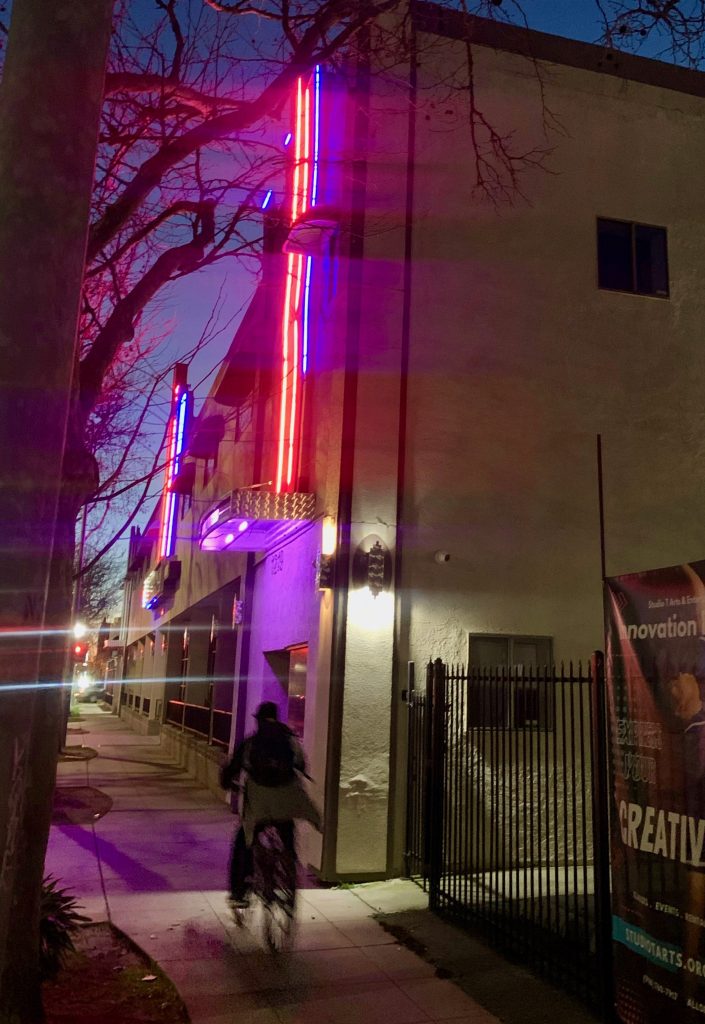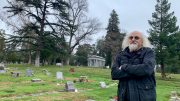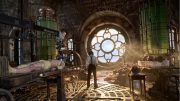Is Sacramento a Noir town? Driving through Southside Park on a rainy night as showers brush the garden lights and Old I’s blazing, scarlet marquee – Duke Ellington’s nocturnal river waves swaying through the radio – one can sense that beautifully bleak aura of lost voices and spent fortunes pervading the mist, and how the battered bones of an aging neighborhood add a stylized fatality to it all.
Like any avenue, S Street has its memories. The happy homicide historian David Kulczyk can tell you how, in 1944, a neighborhood drunk named Eugene Culver shuffled into Old Ironsides, pushed a bottle on his liver, then got into a brawl with a carpenter living above the establishment. The other man, Skip Skeie, was looking for a fair fight. Culver wasn’t. The same ephemeral red touch of the bar sign on fog was signaling through a downpour when Culver whipped his pistol out to shoot the tougher man dead.
Play “Jeep’s Blues” by Ellington while rolling down S Street and you might feel those irreversible moments somewhere in the dancing vapors.
It’s a vibe that carries if your cruise on to Broadway at the Tower Theater, watching those ruby rails glow against a spectral storm-light – its wide Art Deco illumination glassing fountain tops and blushing palm branches that reel in the breeze.
This grand film palace is tied to Noir’s story.
The Tower was built in 1938 on the eve of a world war whose shadow morphed into the genre itself. Billy Wilder, a Jewish writer and director from Poland, understood the rise of the Nazi party for what it was and fled Europe while he had the chance. He soon landed in Hollywood. The lonely themes and gorgeous gloom of Noir came from Wilder’s visions, crystalized by “Double Indemnity” in 1944 and then “Sunset Boulevard” in 1950. “Double Indemnity” is still shown sometimes on the Tower’s big screen, its silvered faces flickering in the same auditorium where it first debuted for film lovers. Twelve blocks away at the Crest Theatre, which opened the year the Titanic sank, “Sunset Boulevard” occasionally plays below its gilded gold engravings.
I don’t know if The Crest featured “Sunset Boulevard” in 1950, but I do know, thanks to Kulczyk, that Downtown was in panic that summer because a raven-haired 22-year-old beauty named Dolinda Montoya Diaz had been kidnapped after sundown while leaving a cannery job by the river. Her bludgeoned remains were found months later in a field far east of the city. Dolinda’s young husband, Nick, would spend the rest of his life not knowing who’d taken his bride from him. And it would not be the last time that happened in Sacramento.
Such strands of doomed romance are an essential spark in Noir, and there’s plenty of them in a new collection by Akashic Books that explores how the genre can manifest itself in the City of Trees.
The anthology was curated and edited by John Freeman, a talented author who grew up in Sacramento. In the preface, Freeman describes how learning the city’s neighborhoods as a young paperboy for The Bee gave him and his brother a taste for the wonders of narrative.
“Some mornings both of us would scan the headlines – even as ten-and eleven-year-olds,” Freeman writes. “Then we’d pedal out into the soupy early morning dark, our bikes weighed down by newsprint, or heads full of stories of the day: earthquakes, double-overtime losses in basketball, the occasional murder, and sometimes a secret pregnancy.”
Freeman adds that he was also a kid tasked with collecting subscription fees in the thresholds of strangers’ homes.
“People revealed themselves,” his intro recalls. “Sometimes with the door opened into a house, I’d hear an argument – the long, grinding argument of an unhappy marriage. I saw people leaving furtively, like they didn’t want to be seen. I smelled what was cooking, or sometimes just sour coffee. Whole worlds of stories piped out during the moments that front door was open.”
With “Sacramento Noir,” Freeman and twelve other dedicated writers have used such portals to celebrate California’s capital as a muse. I’m a longtime fan of the Noir genre, and I know many don’t understand it. Movies that are ‘Film Noir,’ and stories that are ‘Literary Noir,’ are – by definition – tales of the night. Sometimes their blackness is the sky over street lamps. In other instances, it is a veil of moral uncertainty that’s falling on someone’s psyche. Those themes and settings come through in “Sacramento Noir” – a collection of fictional lives battered in lightless alleys at the witching hour.
And, since I am a Noir obsessive who’s also a veteran crime reporter in the city, I’ve decided to clock some real-life tragedies that intersect with local neighborhoods at the heart of this entertaining and thought-provoking book.
Downtown’s illusions of time

The lower central city is haunted – if not by apparitions, then by the wounds of History.
Freeman showcases this in “Sacramento Noir” by including two pieces about Downtown set in very different eras. The one by Naomi J. Williams takes place in 1954, hovering over a death rattle of the West End neighborhood. The other, by Freeman himself, takes place in the present day and turns through an ambulance nightshift and a manslaughter probe on K Street.
Both stories are about the immigrant experience in California.
Williams’ contribution, “Sakura City,” follows a Japanese-American family who own a florist shop in a part of town slated for destruction. That aspect of the story is true. Long before the Capital Mall, there stood the West End – Sacramento’s lively cultural melting pot. Older residents remember it as a dynamic quarter of Black, Latino and Portuguese-owned businesses, along with the fourth-largest Japantown in the nation.
Second Street was the rougher part of the enclave back then, though by the early 1950s, city leaders were framing the entire neighborhood as a crime-ridden “slum.”
Was it really that dangerous? Kulczyk has written about a husband in the neighborhood named Charles Smith who shot his wife in the face in 1950. Helen Smith was killed a couple months after “Sunset Boulevard” premiered, the victim of a man’s possessive rage. However, there were six murders that happened in other parts of Sacramento that year, and a few were far grislier than Helen’s ending. It didn’t matter. The city’s wealthy elite wanted the property for themselves, and they got elected officials to do their bidding through a series of eminent domain seizures, which led to the demolishing its shops and clubs and hotels and churches in the name of “progress.” Many of the Japanese-American families, who’d already endured California’s internment camps, were displaced to Southside Park, an area that some now refer to as Second Japantown.
But in “Sakura City,” Williams recreates Sacramento’s real Japantown with color and energy that practically spills off the page. Williams was born on a US Air Force base overseas. Her father was a serviceman, and her mom was from southern Japan. Williams has lived in the Sacramento area for more than 20 years now, currently residing in Midtown. She says “Sakura City” rose out of a process of research and discovery rather than turning through her own photo albums.
“I was very aware when I was writing this story that it was not my family’s history, and not my own personal history,” the author reflected. “So, to the extent possible, I really wanted to do right by the Japanese-Americans in Sacramento … When I first moved here, I wondered why the city doesn’t have a Japantown. Then, at some point, I heard a little bit about that story – how Japantown had survived the internment camps, but not the forces of re-development.”
Williams dove into the legacy of the West End. The result is a gripping story about dark family ciphers guarded by questions and silence. The feeling of place that “Sakura City” musters is linked a knowledge of inevitable demise.
For Williams, it was important to begin her plot with an actual political referendum in 1954 to build-over the West End.
“Even after losing this referendum that was trying to raise money to raze the neighborhood, even after they failed to do that, the City found a way to destroy the neighborhood anyway,” Williams observed. “And people really did fight this – but they lost … Walking around down there, now, this definitely changed my relationship to that part of the city. The project helped me feel connected to the city in a way I never have before, but now when I pass by big parking lots where they had been nice craftsman homes once occupied by people of color, I feel mad – I feel angry. That just didn’t need to happen, especially not in the incredibly unimaginative way that it happened.”

And what got ushered in by this so-called progress hitting Downtown in 1957? Within eight years, the neighborhood’s residents were watching the grim, Brutalist monstrosity of the Gordon D. Schaber Courthouse be built at H and 9th. It was inside that unattractive building that a very attractive young woman named Nancy Bennallack began working as a court reporter. Judges, attorneys and bailiffs all knew Nancy. She was a constant presence around the building: In fact, Nancy was so entwined in Sacramento’s halls of justice that she was eventually engaged to the city’s Chief Public Defender, Farris Salamy.
Nancy was spending time with her fiancé on an October night in 1970 – a month before their wedding and just days before Halloween. The couple was at Nancy’s apartment on Bell Street past the north city line. Around 11 p.m., Farris said goodbye to his intended and went home. At some point in the night, an unknown man climbed onto Nancy’s upper balcony, pushed through a slightly open glass door for the cat, and then went on a slashing frenzy directed at the would-be bride. The crime scene was bad.
Despite a massive effort from law enforcement, Nancy’s murder went unsolved for decades. Farris Salamy had been cleared as a suspect. One can only image what his life was like working at the Downtown courthouse as the days became years, and the years became uncountable – all with zero progress on Nancy’s case. The crime weighed on every judge, attorney and court reporter who had admired Nancy.
Finally, in the summer 2022, Sacramento Sheriff’s homicide detective Mickie Links – a woman who’d helped catch the Golden State Killer – used genetic genealogy to solve the riddle of Nancy’s slaying a half-a-century after her blood was spilled. News & Review covered that winding investigative journey in our feature “The Cold 52.”
Nancy and Farris were one of the city’s fated Downtown connections. In John Freeman’s own contribution to “Sacramento Noir,” he brings readers to the urban core through the lens of another entanglement, one processed in the memories of a paramedic working ‘graves.’
Freeman’s lead character, Ramy, is a Palestinian who’s chosen Sacramento for self-exile. People tell him he has “a haunted face.” Others talk to him about Muslim stereotypes and UFO sightings. No one seems to wonder how Ramy’s arrived at his forlorn existence behind the wheel of an ambulance, mostly waiting for lonely night-dwellers who needs lifts to the Emergency Room.
As Ramy and his partner are dispatched to a fatal hit-and-run on K Street, they encounter homicide detectives – fictional mirrors of real counterparts like Mickie Links – as well as a corpse that needs chaperoning to its final destination. But this presence of Death as the city sleeps is just a witness mark in time for Ramy, whose mind keeps drifting an ocean away and to the choices he made during a dangerous affair.
There’s a body on K Street and a beauty somewhere back in Gaza.
A man who’s unable to control his attraction to a woman promising trouble is one element of Noir that goes back to Billy Wilder; and in “Intersections,” Freeman introduces you to a character who thinks it like he’s lived it.
Shadows on the Waterfront

The city’s oldest docks watch over a river of secrets.
Those planks and railings have stood by secrets for generations: They’ve known the secrets of a North Irish wanderer who built a newspaper empire; the secrets of a Mormon propagandist who got rich off miners’ dissipated dreams; the secrets of a first-elected sheriff who was shot dead on a street over the bridge; and the secrets of an entire community of people from Guangdong province in China who arrived to dig gold deposits, built new towns and help forge a railway across the continent.
A fog of uncertain secrets permeates “Ghost Boy,” Jen Soong’s contribution to “Sacramento Noir.”
Set in modern times, “Ghost Boy” is about pill-popping Gina Lee, a pharmacy worker in Old Sacramento trying to care for her sick grandmother and outrun a doom-fortune that’s been cast over her since she was little.
Fitting for a Noir collection, Gina is not a glamorous character. She lives in squalor and her own slow-motion unraveling. But her story is gripping from the jump.
Soong is the daughter of Chinese immigrants. A former journalist who earned her MFA at UC Davis, she’s lived in the Sacramento area for the last eight years. Soong is also a fan of one of my own favorite Noir films, Hitchcock’s “Notorious.” I’m not surprised. In “Ghost Boy,” she evokes a similar tension between caring and nihilism, and does so by using the shabby charisma of a run-down river city.
She also includes her own nod to immigrant families.
“I thought it was really important to center a Chinese-American protagonist in the story, which you don’t often see in Noir,” Soong acknowledged. “For me, this is the kind of sordid tale that gets gossiped about by aunties at mah-jongg tables.”
In the past, there’s been plenty of sordid things to whisper about along the waterfront. During the Jazz Age, Sacramento newspapers warned readers about “fiends” who stalked the riverbanks. Those omens proved-out in the spring of 1924 as the city was throwing its huge 75th anniversary for the discovery of gold. City fathers were hailing the bash ‘49 Day.’ Hundreds of partiers crowded into the streets of Old Town. One of them was 22-year-old D.L. Ingram. He was a man with nothing in his pockets and murder on his mind. Ingram carefully used all the jubilation as cover to stalk a stranger down to the edge of the river. Then he launched an ambush. After robbing and killing the stranger, Ingram slid his body into the dark waves of the Sacramento. But newspaper reports noted that, once Ingram fled up river, he began to wonder if he was losing his mind. He was sure that he’d taken a life. Or was he? With his grip on reality getting murkier, Ingram turned himself into law enforcement. He confessed to officers about the murder in Old Sacramento, though he didn’t know the victim’s name. In this case, a body was never recovered from the river, leaving a perpetual question of whether the dead man ever existed or not.
That same surrealist haze is what gives “Ghost Boy” it’s magic.
Soong says that the contours of Old Sacramento helped her invent this tight little psycho-drama around questions of what’s known.
“I see the location, the city itself, as almost being character story,” she explained. “It was about bringing in all these different elements of the neighborhood – the sound of the train – that history of an old Chinese market that character’s mother took her to. I wanted to capture some of those elements of the city that I really find fascinating.”
Uptown blues

Del Paso Heights is a perfect canvas for faded isolation. It was a bustling place in the days of Billy Wilder. Now, its main boulevard is lined in weathered, semi-dilapidated Art Deco buildings that murmur of past and vanquished glories. Walking it at twilight, one passes the hot light-tubes of Iceland’s marquee burning their fire-reach of rose into the darkness.
William T. Vollmann, one of the most-admired writers in Sacramento, chose to set his piece for “Sacramento Noir” in this section of the city.
His story, “A Reflection of the Public,” centers on life in a homeless camp where people are self-medicating their social abandonment through camaraderie, sex, pills and methamphetamine. With its attention to character contradictions and unabashed eroticism, Vollmann’s piece is the collection’s clearest example of a sub-category of the genre called ‘Neo Noir.’
I’ve written plenty of news reports that involve meth and pills in Del Paso. The people trying to survive in the area’s encampments aren’t typically involved in crime, but the traffickers bringing drugs into the neighborhood have a knack for making grim headlines. That was clear from SN&R’s crime feature “Midnight Burning,” which primarily took place around Beaumont Street and Rio Linda Boulevard. The saga started with a beef between “the Paisas” and some hard ass north city ice-slingers, then quickly escalated into multiple shootings, two car fires, one ill-advised betrayal and a double-execution with matches and gasoline.
Torching two men alive is no little thing, even in the drug world.
Often times, when readers saw my coverage of the men who did it – Joshua “Whetto” Smith, Laurencio “Goppy” Quintero and Richard “Richie” Gutierrez – they wanted to know about their gang affiliation. Were they Norteños? Sureños? Latin Kings? Did they work for Mexican drug cartels? Which group in Sacramento had blood icy enough to send that kind of message? To me, the links seemed loose and distant. Whetto, Goppy and Richie were just guys who loved rolling around Del Paso Heights, hawking crank, flashing guns and buffing-up on anyone who looked at them wrong. I don’t know how clicked-in they were, but they sure did a lot of gangster shit.
Violent drug-runners are real enough in Old North Sacramento, but what is more common are the everyday people of the camps, the ones struggling to exist in the capital of a state with the highest poverty rate in the U.S. Their stories can be curious. Their stories can be sad. Their stories can be relatable. Vollmann brings some empathetic table-setting around this reality in “A Reflection of the Public.” The story takes readers through the interior lives of those living outdoors in Sacramento. Vollmann pulls the curtain back on failed shut-ins, teen runaways and mauled combat veterans who share a hidden but not hidden existence north of City Hall. A common mantra in Noir amounts to having to take one’s licks and carry on; and in Vollmann’s piece, that victory is accomplished through bonds formed by unlikely families.
Time and again, the journeys in “Sacramento Noir” probe human nature in thoughtful, edgy ways. Reyna Grande’s brilliant piece “The Sacrament” opens the door to temptations of the heart and flesh in the old Colonial Revival houses of East Sacramento. Maceo Montoya revisits a moment when artistic ambitions met social revolution in the city through the Royal Chicano Air Force. That’s in his story “A Significant Action.” Author appearances and readings for the new collection are slated for March 6 at Time Tested Books at 7 p.m., March 7 at the CLARA Auditorium at 7 p.m., March 10 at Avid Reader at 6 p.m. and April 5 at Capital Books at 2 p.m. While Akashie has previously released Noir collections for other cities all over the world – Rome, Paris, Los Angeles, New Orleans – Jen Soong thinks Sacramento’s entry into the fray arrives at a compelling moment for literature.
“These are really strange times were living in, so it might be the perfect time to read this type of collection of Noir stories,” Soong pondered. “They examine the fates of various people caught in troubling circumstances that are seemingly beyond their control. I feel like that’s very timely. For some people, that might be escape. For others, it might be another way to look at what we’re going through in this current strange, surreal world.”
Scott Thomas Anderson is also the writer and producer of the true crime documentary podcast series “Trace of the Devastation.”






Be the first to comment on "Nightshades: ‘Sacramento Noir’ is a book that conjures fiction mapping onto the city’s true murders and dark memories "